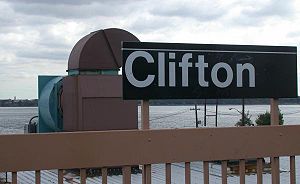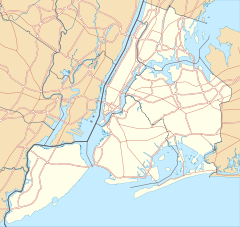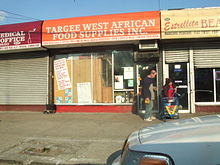- Clifton, Staten Island
-
Clifton or Park Hill is a neighborhood in northeastern Staten Island in New York City in the United States. It is an older waterfront neighborhood, facing Upper New York Bay on the east. It is bordered on the north by Stapleton, on the south by Rosebank, on the southwest by Concord, and on the west by Van Duzer Street.
Contents
History
The name "Clifton" for the area dates to 1817, when a town by the name, larger in area than the present neighborhood, was laid out along the waterfront. In its early history, much of the surrounding land was owned by the Vanderbilt family. As a young man, Cornelius Vanderbilt established ferry service from the waterfront to Manhattan at the foot of present Vanderbilt Avenue. Bayley Seton Hospital, north of Vanderbilt Avenue, was formerly the United States Public Health Service Hospital and housed the original headquarters of the National Institutes of Health (now located in Bethesda, Maryland). In the 1840s the Townsend family built a huge home that had turrets so it was called the Townsend Castle. It was located at what is now Townsend Avenue and Tomkins Avenue. In the 1870s many roads were built near the water and many large homes were built in the area near the water. The area has many Victorian houses left from the late 1800 in the area from Vanderbilt to Norwood avenues. In 1900 the Fox Hills Golf Club golf course encompassed the entire area of where the park hill apartments are now. There was a big clubhouse on Vanderbilt avenue. Many tournaments were held there until the 1920s when it closed. The land was taken over by the government and uses for military barracks during world war II. By the 1950s, it evolved into a middle-class, multi-ethnic community of civil employees including firemen, teachers, and doctors.
The Park Hill Apartments, a privately-owned but federally-subsidized low-income housing complex on Vanderbilt Avenue, and also on Park Hill Avenue, became the site of steadily increasing crime and drug abuse beginning in the mid-1960s; by the late 1980s it had gained the nickname of "Crack Hill" due to the many arrests for possession and/or sale of crack cocaine that were taking place in and around the development and the adjacent Fox Hills Apartments to the south. However, crime in this area has dramatically decreased since the late 1990s. Community activists are addressing the ongoing conflict between Liberian and African American youth, primarily between the ages of 10-14. The community organizations run after-school programs to help keep the youth occupied in a productive way. This helps curb gang and street violence. The community tension that occurs in Park Hill is based on poverty and unemployment.
In the 1990s, the neighborhood became the center for an immigrant community from Liberia and West Africa around Targee Street. The residences in the neighborhood are mostly one-family houses, but the last decade has seen the development of many attached homes and duplexes. The neighborhood Staten Island Railway station is three stops from the ferry at St. George. Many members and affiliates of the Wu-Tang Clan hail from here, including Method Man, Raekwon, Inspectah Deck, Cappadonna, King Just and U-God.
Public Health
Due to the lack of health care, the death rate in the Park Hill area is 25% higher than in the remainder of New York City. Although the area does promote health care, 80% of the population is uninsured and there are no resident doctors. As a result, the populus of the area is more susceptible to disease. By law, children can not enter into school without the proper immunizations; however, it is difficult for uninsured youth to receive them. As there is no public hospital in the area, options for sick or mildly-injured residents are lacking. Facilities are located far from Park Hill and out of the way of public transportation routes.
Park Hill struggles with environmental issues involving pollution and litter. The community's public school system plays a large role in environmental protection including park clean up, lake maintenance, and litter removal. Eibs Pond, part of a 17-acre (69,000 m2) wetland adjacent to the Park Hill community, was recently restored by the current students of PS 57.
Liberian community
Park Hill/Clifton (along with nearby Stapleton) has the largest Liberian population of any city outside Africa,[1] with an estimated 6,000 - 8,000 strong community of direct immigrants in 2007.[2]
The Liberian Civil War led to a flight of Liberian immigrants, fleeing ethnic struggles between the between Kru, Gola and Grebo communities, corrupt government, and political strife. Beginning in the late 1970s, a small number of Liberians, whose nation was founded by freed American slaves in the 1840s, settled in Staten Island. In the late eighties and early 1990s, Liberian immigrants in huge number fled the country, mostly trapped in the limbo of refugee camps on the borders of Guinea and Cote d'Ivoire. The United States government, always highly involved in Liberian affairs, began to offer refugee status (Temporary Protected Status-TPS)[3] to displaced Liberians, especially those who had family in the United States.
The Liberian community in Clifton has been involved in a string of government lobbying campaigns since the 1990s to extend the "deferred enforced departure" (DED) status, which since the Presidency of Bill Clinton has had to be deferred on a yearly basis by presidential order for immigrants who fled the Liberian war without immigration visas. Clifton based community groups like the Staten Island Liberian Community Association (SILCA) have become politically active in defending the estimated 3,600 Liberians across the country who are on DED status.[4]
This new wave of immigration settled near the first small handful of Staten Island Liberians in the Park Hill Projects (now private apartments). As the civil war intensified, more immigrants followed, creating a vibrant community with African restaurants and businesses, and others working and building businesses across the area, notably in the Nostrand Avenue area of Brooklyn. The wife of soccer star (and former Liberian presidential candidate) George Weah owns a business in Brooklyn and lives in Staten Island. In recent years, Liberian families have been settling in nearby New Jersey, with a large community in the Trenton, New Jersey area. The area has become a regular stop for Liberian politicians and leaders visiting the United States. Local Liberian civic groups organize Liberian-Americans involvement in their homeland, and promote a variety of charitable missions in West Africa.
Troubles from home
But the troubles of the Civil War period have been carried into the diaspora as well. There are thought to be dozens of former child soldiers living in the Park Hill area. These former child soldiers are often unwilling to talk about past experiences and fear judgment (or prosecution) for wartime deeds. Because of the large population of Liberians in the neighborhood, the Liberian Truth and Reconciliation Commission established after the civil war sent a representative to Clifton to collect testimony from Liberian nationals who experienced the Liberian Civil War and who currently reside in the neighborhood.[5]
Troubles here
While there are successful business leaders in the community, the vast majority of Staten Island's Liberian immigrants are employed in low wage service or medical fields. Many of the current residents of Park Hill are struggling with illiteracy, difficulty in finding employment, and poverty. Liberian immigrants in Park Hill also suffer from the legacy of poverty and violence in the wider community in which they live. While crime in the area has improved over the last 20 years, the reputation of the Park Hill for gang and drug violence has afflicted some Liberian youth, already victimized by the Civil War. Liberian youths caught up in criminal activity, if arrested as refugee status visa holders, face deportation back to their homeland. Friction between the Liberians and some in the local African-American community, over jobs, housing, and culture, has also been a source of tension for an already troubled community. [6]
Housing
The bulk of the Park Hill neighborhood was built in the 1960s in keeping with New York City's plan for urban renewal projects. It consists of 15 acres (61,000 m2) of 6-story brick apartment buildings. The individual apartments contained within are quite large, with many having 2 or three bedrooms. As ownership has passed into private hands, upkeep on the apartments has dwindled, leaving many of them currently in a shabby state of disrepair.
The average price of a private house in Park Hill has increased from 2002 to 2007. In 2002, the average price of house was $159,254 and in 2007 the average price of a house increased to $321,426. The Clifton neighborhood consists mostly of one family houses, however, in the past decade many duplexes and attached houses have been developed on property previously zoned for commercial use.
Traffic
In the early 21st century Staten Island is New York’s fastest growing borough which has led to increased traffic congestion. Many city agencies believe that the streets of Staten Island lack the proper infrastructure to support the growing use of automobiles. The Staten Island Transportation Task Force and Co-Chairs New York City Department of Transportation (DOT) Commissioner Iris Weinshall and Department of City Planning (DCP ) Director Amanda Burden have acted to relieve the congestion in the Staten Island Park Hill area. Staten Island has a low rate of mass-transit ridership in the area as compared to the other boroughs, according to the MTA. The DOT has outlined several short-term, mid-term, and long-term goals which include safety enhancements, bus stop additions, street widening, and traffic light reconfiguration. The placement of more "Stop" and "Yield" signs in the neighborhood is another pertinent goal.
Income
Over the years 2000–2003, average wages in the area declined by 8.7 percent. This was the only zip code in Staten Island which had a declining wage level. Unemployment is increasing. It increased by 3.2 percent by 2003. The closing of Bayley Seton Hospital is disastrous to many residents. Most of the jobs that people in the Park Hill have are in the health care and social assistance. The closing of a major hospital will cause unemployment to increase. From the year 2000–2003, the number of people in this are, working in the health and social assistance field, has already decreased by 5%[citation needed].
In the perception of the residents of Park Hill, a good way to improve income levels is to make sure the children get a good education in local primary and secondary schools.[citation needed]
Education
Clifton is served by the intermediate school I.S.49 and the elementary school P.S.57.
Transportation
Cifton is served by the S51/S81 bus along Bay Street, the S52/S78 bus along Tompkins Avenue, the S74/S84 bus along Targee Street/Van Duzer Street, and the S76/S86 bus along Vanderbilt Avenue (weekend service was eliminated on June 27, 2010). It was formerly served by the X18 express bus until June 27, 2010, when it was eliminated.
See also
References
- ^ New York City Commission on Human Rights: Staten Island Office. The actual text says "outside Liberia". As other sources document well over a million Liberians were living in refugee camps within West Africa during the first decade of the 21st century, "largest outside Africa" seems more accurate.
- ^ Figures are estimates. The OECD estimates just over 28,000 Liberian born people live in the United States. http://www.oecd.org/dataoecd/18/23/34792376.xls
- ^ Fact Sheet: Liberians Provided Deferred Enforced Departure (DED), Department of Homeland Security. September 12, 2007. Press release on 2007 deferment of status hearings for Liberian refugees in the United States until 2009.
- ^ Ryan, Rich (2009-03-21). "Staten Island's Liberian Community Rejoices at Extension". Staten Island Advance. http://www.silive.com/news/index.ssf/2009/03/staten_islands_liberian_commun.html. Retrieved 2009-03-22.
- ^ Barry, Ellen (2007-09-18). "From Staten Island Haven, Liberians Reveal War’s Scars". New York Times. http://www.nytimes.com/2007/09/18/nyregion/18liberians.html. Retrieved 2010-01-26.
- ^
- Trying Times in Little Liberia. On Staten Island, Reflections of a War-Torn Country. Johnny Dwyer. The Village Voice. August 19th, 2003
- [http://www.motherjones.com/commentary/columns/2007/07/witness.html The Child Soldiers of Staten Island: While Hollywood swoons over teen guerrillas, the real lost boys are hidden in plain sight. Alissa Quart. Mother Jones Magazine June 30, 2007
- African Refuge, youth counseling center for Liberian youth on Staten Island.
- The Liberians of Staten Island. New York Voices, Thirteen, WNET, New York.
- From Staten Island Haven, Liberians Reveal War’s Scars, Ellen Barry, the New York Times, September 18, 2007.
- Photos from the New York Liberian soccer team's game in the African Cup of Nations. Ruthie Ackerman. Pulitzer Center on Crisis Reporting.
- Liberia: From One Battlefront to Another. January 11, 2008 . Pulitzer Center on Crisis Reporting.
- Liberian president to attend black heritage parade here. Staten Island Advance, 01 October 2007.
- Tense wait for NY Liberians, Jane Standley, BBC correspondent in New York. 17 July 2003.
- Liberian Truth & Reconciliation hearings expand across country. African News Journal. September 09, 2007
- A View of Liberty. Matt Reed, NYC24: the New Media Workshop at the Columbia University Graduate School of Journalism.
- Liberian Connection: Staten Island based news service.
- The Liberian Mandingo Association of New York: Staten Island based Liberian community group.
- Anonymous, Illustrated sketch book of Staten Island, NY: Its industries and commerce, New York 1886 page 133, Excerpt at www.rootsweb.ancestry.com/~nyrichmo .
- Stapleton, Clifton, and Rosebank, forgotten-ny.com.
- Liberian asylum-seeker keeps memory of victims alive
- [1]
External links
- Clifton, Staten Island is at coordinates 40°37′13″N 74°04′39″W / 40.620207°N 74.077463°WCoordinates: 40°37′13″N 74°04′39″W / 40.620207°N 74.077463°W
- Eibs Park at New York City Parks Department
- Child Soldiers of Staten Island from Mother Jones
- Exiled to a War Zone, for His Safety from The New York Times
Categories:- Neighborhoods in Staten Island
Wikimedia Foundation. 2010.




